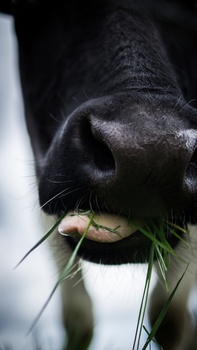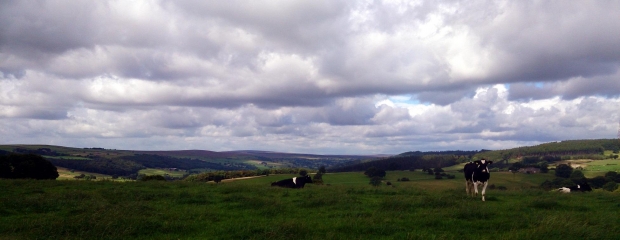
For those of you who are not lactose intolerant and maybe even some who are, dairy can be a beneficial part of a healthy diet. Unfortunately, there are many unhealthy and misleading products out there. I would like to demystify the selection process of healthy dairy.
Let’s start with where the milk comes from. This article will refer to dairy from cattle specifically, but is applicable to all types of dairy/milk (cow, goat, sheep, yak, camel, reindeer, water buffalo, etc).

Most milk on the supermarket shelf today is from large scale dairy farms. So, I will start with the background of that which is most common.
The day in a life of this particular dairy cow is spent in a tiny stall, on a hard cement floor, and in an overcrowded building. The cows are hooked to milking machines for the majority of the year. This does not remotely resemble any natural way of life for any livestock.
Due to the concentration of animals in such a compact space, there is an enormous amount of waste that must be dealt with. Most of this waste ends up being forced unnaturally into the environment, polluting waterways and devastating ecosystems. In pasture based systems, the manure is integrated back into the earth to enrich the soil and improve the land in a much more sustainable way.
Due to the nature of these confined operations, the cattle do not have access to fresh grass and are fed a diet of grain. The majority of this grain consists of corn and soy (not a natural diet for cattle), which receive extremely heavy applications of herbicides and pesticides. These toxins ultimately end up in the milk. In addition to this grain based diet, it is legal to feed rendered animal products to the cattle. I would prefer not to get into this aspect, but you can read more here.
The confinement of these animals, as well as the unhealthy living environment, leads to sick animals that require constant ingestion of antibiotics, which are also added into their feed. This is to ensure that the animal is kept alive and producing. As a result, the antibiotics are transferred into the milk in which you drink.
Sounds pretty miserable, right? Well it is obvious in comparing the average lifespan of a factory farmed, confined operation dairy cow, which is 42 months, to the average lifespan of a smaller scale pasture raised dairy cow, which is 12-15 years!
As with other production based businesses, the concept of more is better has driven the development of synthetic hormones to make the cattle produce more and more milk. In the early days, dairy cows produced about 1 ½ gallons of milk daily. Then farmers began selectively breeding cows that produced about 4 ½ gallons of milk per day. Now, with the addition of synthetic hormones, the average dairy cow produces over 6 gallons of milk per day. That is about 50 pounds of milk per day, per cow. The side effects of these synthetic hormones which plague the cattle are reproductive issues, deformities, the increased occurrence of mastitis, the increased need for antibiotics, foot issues, and digestive problems to name a few. Due to the increase in sickness and infection, the milk is lower in quality and contains fluids other than milk such as pus, unhealthy bacteria, and blood.
To deal with all of these issues, the process of pasteurization was introduced to the dairy industry in order to clean the dirty milk. This heat treatment, to kill bacteria, does not remove the herbicides, pesticides, antibiotics, or hormones from the milk. In essence, pasteurization is a means to cover up dirty milk. In order to convince the public to buy pasteurized milk, the big milk producers claimed it to be superior and healthier than raw milk. They began blaming raw milk for numerous diseases until the public bought into it. These claims were not based on unpasteurized milk from clean facilities and pasture based systems.

In reality, there are more risks in drinking pasteurized milk than clean raw milk, due to the protective nature of beneficial bacteria. On the microscopic level, it is all about competition. When the milk is pasteurized, all life is wiped out, “good” and “bad”. This increases the likelihood of contamination. Pasteurized milk goes rancid as opposed to raw, living milk, which becomes cultured. The healthy microbes eat up all the sugars in the milk and produce a soured product with beneficial properties. With modern day milking equipment and transportation, it is more than possible to get clean and healthy raw milk to store shelves.
Pasteurization also decreases the nutrient value of the milk. This includes the loss of over half the vitamin A, D, E, and C. Vitamin B6 and B12 are actually completely destroyed during this process. Pasteurization decreases the digestibility of milk because it destroys enzymes that aid in digestion, such as lipase that helps break down fat and metabolize the fat soluble vitamins A and D. This is why the dairy industry has to fortify the milk with less than optimal sources of vitamins. Raw milk is a better source of calcium than pasteurized milk because this process also destroys phosphatase, which is essential for the absorption of calcium.
You will even see dairy products in the store that are “ultra-pasteurized”. Big dairy producers propose this higher temperature and longer treatment time as a response to certain microbes that they claim have become heat tolerant to the original pasteurization. There are other, less appealing to the consumer, reasons for ultra-pasteurization such as a longer shelf life. This means your milk can be 3-4 weeks less fresh when you get it. Another drawback is that it tastes burnt, and is now an ultra dead food. Most major brands use this process now, even certain organic brands.
Another common process dairy is put through is homogenization, which makes a more “uniform” product by breaking up the fat globules and dispersing them evenly throughout the milk to prevent the cream from rising. This eliminates the need to shake it up first. A large portion of the population is also fat-phobic and seeing the cream on top may be deterring for some. This breaking up of the fat globules increases the surface area of the fat exposing it to more air and oxidation. This makes spoilage more likely to occur. It has even been shown that consuming homogenized products contributes to heart disease and atherosclerosis.
Considering all of this, it is no wonder that there are so many allergies and conditions associated with milk consumption and improve with its removal. This is why it is important to choose milk in the wholesome, unadulterated, living form. Selecting dairy products from farmers who practice sustainable, regenerative, and ethical production methods will contribute to the well being of the animals, the environment, as well as those who consume the products. So choose real, unprocessed, full-fat, milk and dairy products from pasture-raised and happy cows.

Real, unprocessed, full-fat, and pasture-raised milk contains many important nutrients such as vitamin A and D, calcium, vitamin B6 and B12, CLA (conjugated linoleic acid - reduces body fat), complete protein, and plenty of necessary enzymes. It also contains beneficial bacteria for the health of your gut and intestinal flora. Culturing the milk takes these beneficial properties up a notch. Cultured milk products contain increased amounts of probiotics and enzymes that have a therapeutic effect on your health.
In some states, unpasteurized milk is legal. In most states it is not legal to buy at stores, but is okay to buy direct from the farmers. There are some awesome buying clubs out there to make this nourishing food more accessible. Check out The Real Milk Campaign to find a nutritious source near you! If you would like to dig in more to the history and topic of unheated, unprocessed milk, this site is loaded with incredibly detailed information.
For those who want to know more about the many healthy forms of raw dairy and how to select them, keep an eye out for my future musings!

Do you drink unpasteurized milk?
Do you want to try it?
Let me know if you have any questions or would like further guidance in this quest for the best!
